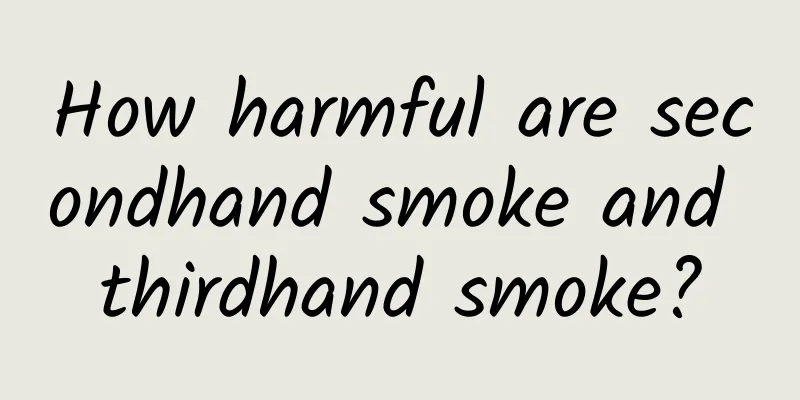How harmful are secondhand smoke and thirdhand smoke?

|
Recently, a couple in their 60s were diagnosed with lung cancer. The wife said that her husband had been smoking for nearly 50 years, but she did not expect that she would get lung cancer before him. If one of the spouses smokes, the other will inevitably be exposed to secondhand and thirdhand smoke. Smoking is the leading cause of lung cancer. Even if you do not develop lung cancer, tobacco can cause other serious damage to lung function. Image source: Big Reference Video Whenever I persuade people around me to quit smoking, I am always choked by such words: "The guy next door has smoked all his life and is still living well..." There are also similar words like "I smoke and my health is not good, it has nothing to do with you". In fact, smoking is not only harmful to the smoker's body, but second-hand smoke and third-hand smoke are also very harmful to other people, even more than the harm to the smoker himself! 1 What is secondhand smoke and thirdhand smoke? When a smoker lights a cigarette, he or she inhales filtered smoke, and the remaining unfiltered smoke becomes "second-hand smoke". Second-hand smoke is a mixture of two types of smoke: sidestream smoke and mainstream smoke. Sidestream smoke refers to the smoke that comes directly from a cigarette, cigar or pipe, while mainstream smoke is the smoke that comes out of the smoker's mouth. Image source: Science Panda There are about 250 toxic substances in secondhand smoke, at least 69 of which are carcinogenic, including metals, tobacco-specific nitrosamines and polycyclic aromatic hydrocarbons. According to the World Health Organization, tobacco kills more than 8 million people worldwide each year, of which 1.2 million non-smokers die from diseases caused by secondhand smoke exposure. At the same time, secondhand smoke exposure is also an important factor leading to coronary heart disease. Thirdhand smoke actually comes from secondhand smoke, but its ingredients are more complex than those of secondhand smoke. "Thirdhand smoke" refers to the residual tobacco smoke attached to surfaces such as clothes, walls, carpets, furniture, and even hair and skin. The toxic ingredients it contains include hydrocyanic acid, butane, toluene, arsenic, lead, carbon monoxide, and more than ten highly carcinogenic compounds. Thirdhand smoke adheres to any object it touches and accumulates over time, penetrating into floors and walls, making it difficult to remove and clean. In addition, thirdhand smoke adsorbed on the surface of objects will be re-emitted into the air, reacting with oxidants and other compounds to produce secondary pollutants. Studies have shown that nicotine remaining in tobacco smoke reacts with nitrous oxide in the environment to form carcinogenic tobacco-specific nitrosamines. 2 How harmful are secondhand smoke and thirdhand smoke? Many people believe that smoking will not affect the health of their family members as long as they do not smoke in front of their family members, but this view is wrong. Relevant research shows that even if smoking parents do not smoke in front of their babies, nicotine metabolites such as cotinine can still be detected in the urine of their babies, and the content is 5.58 times that of ordinary babies. The harm of inhaling second-hand smoke and third-hand smoke may be greater than that of smoking! This is because the smoke emitted after a cigarette is lit has higher levels of some carcinogens than the smoke inhaled, such as 5 times higher carbon monoxide, 3 times higher tar and nicotine, 4 times higher benzene, 46 times higher ammonia, and 50 times higher nitrosamines. When these substances are inhaled into the respiratory tract through the nose by non-smokers, they can also damage the tracheal epithelial cells and induce cancer. Image source: Science Panda For women, long-term exposure to secondhand smoke can lead to premature aging, menstrual disorders, low estrogen, osteoporosis, and in severe cases, cervical cancer, uterine cancer and other diseases. Children are more vulnerable to the harm of third-hand smoke. They crawl around and play all day long, and often come into contact with contaminated surfaces. Since infants and children weigh less than adults and have weaker immune systems, the most direct consequence of inhaling these harmful substances is respiratory problems in infants and young children, such as acute bronchitis and asthma. In addition, tobacco residues in the environment can also cause considerable harm to children's nervous system, respiratory system, circulatory system, etc. 3 How to minimize the harm of secondhand smoke and thirdhand smoke? If you cannot avoid frequent exposure to secondhand smoke or thirdhand smoke, you can minimize the harm caused by secondhand smoke or thirdhand smoke by taking the following measures. **Open windows for ventilation. **Even if you only smoke one cigarette indoors, you need to open windows for ventilation for more than 16 hours to restore the PM2.5 concentration to the previous level. In addition to opening windows for ventilation, you can also place green plants indoors and use an air purifier when necessary. **Wash your clothes promptly. **If someone is smoking around you, do not stay in a smoking environment for a long time. Change clothes and take a shower after returning home. Replace items that may contain third-hand smoke, such as clothing, curtains, carpets, bedding, etc., promptly, and avoid leaving smoking supplies indoors. **Eat more fruits and vegetables. **Eat more fresh fruits and vegetables rich in carotene and vitamin C, and drink some green tea. These foods can help remove free radicals produced by smoke entering the human body and reduce damage. **Stay away from smokers. **Try to spend less time in smoking areas outdoors, especially for special groups such as infants, teenagers and the infirm. When traveling, try to stay in non-smoking areas. When riding in a car, choose a non-smoking carriage; when staying in a hotel, choose a non-smoking room. **Persuade others to quit smoking. **If you cannot avoid it, you should firmly say "no" to smokers and ask them not to smoke in public places. Cancer is the result of the combined effect of multiple factors, and smoking is only one of the important factors. However, it is the most important factor and a factor that can absolutely be controlled. For the sake of your loved ones, your children, the people around you, and your health, quit smoking! END Source: Science and Technology Daily, Chinese Center for Disease Control and Prevention Life Times, People's Daily, Science Panda, Guangdong Health Information Editor: Guru |
<<: You stay at home with your cat, the cat: emmm, it’s too annoying
>>: There is a way to save the dinosaurs! But it's 66 million years too late...
Recommend
After 5G, why did 5G-A emerge?
At the 2024 Mobile World Congress held not long a...
Why are humans right-handed?
"Why are humans right-handed?" is a que...
Foxconn Chairman: Mass production of electric vehicles in the United States in 2023, transition to high-tech products
Foxconn's parent company, Hon Hai Group, rece...
How do Facebook, Dropbox, and HubSpot calculate customer acquisition costs?
Among all the factors that affect a company's...
Tesla Model S collided head-on with a truck, driver only suffered minor injuries
Recently, according to a report on the electrek w...
The latest news on Beijing’s epidemic lockdown in 2022: When will things return to normal? Attached is the unblocking standard!
Recently, four clustered epidemics have occurred ...
Your mobile phone data may be hidden in the western region of our country! ! ! | Great Power Technology Fan
Cloud computing, big data, 5G, artificial intelli...
APP promotion: How to cultivate core users!
Why do you want to be a core user? What is the ul...
If information flow advertising can achieve these 3 points, the effect will be reversed in minutes!
A page that can stimulate users' desire to co...
How to play the whole network integrated marketing? The most complete Internet marketing secrets revealed!
I just joined a new company some time ago, and I ...
Want to be in the same frame with the Chinese space station? Here is a super simple guide
[[434854]] On October 16, the Shenzhou 13 spacecr...
2019 Marketing Promotion Hotspot Calendar (Practical Collection)
Without further ado, the "2019 Marketing Hot...
Many people eat this kind of meat every day! Not only does it damage the cardiovascular system, it also increases the risk of diabetes
Let's talk Friends who like to eat meat are r...
Get these six points, attracting seed users will not be a problem
After everyone has experienced the first three ti...
Rags and sweaters alert! Are humans powerless against moths that eat sweaters?
Leviathan Press: It’s hard to have a favorable op...









